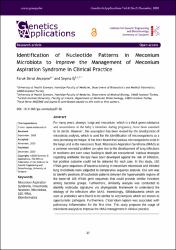Identification of nucleotide patterns in meconium microbiota to improve the management of meconium aspiration syndrome in clinical practice
Citation
Akçeşme, F. B., İş, Ş. (2020). Identification of Nucleotide Patterns in Meconium Microbiota to Improve the Management of Meconium Aspiration Syndrome in Clinical Practice. Genetics & Applications, 4(2), 27-36.Abstract
For many years, airways, lungs and meconium, which is a thick green substance and accumulates in the baby’s intestines during pregnancy, have been assumed to be sterile. However, this assumption has been revised by the development of microbiota analysis, which is used for the identification of microorganisms as a new promising technique; it has been found that various microorganisms exist in the lungs and in the meconium fluid. Meconium Aspiration Syndrome (MAS) as a common neonatal problem can give rise to the development of lung infections in newborns and even cases leading to death are encountered. Various strategies regarding antibiotic therapy have been developed against the risk of infection, but positive outcome could not be obtained for each case. In this study, 16S rRNA gene sequences of bacteria existing in meconium microbiota and infected lung microbiota were subjected to comparative sequence analysis. Our aim was to identify positions of nucleotide patterns between the hypervariable regions of the bacterial 16S rRNA gene sequences that could provide similar functions among bacterial groups. Furthermore, similarity analysis was conducted to identify molecular signatures via phylogenetic framework to understand the etiology of the infections after MAS. Interestingly, Bifidobacteria which are used as probiotics were found to be similar to Actynomyces which are known as opportunistic pathogens. Furthermore, Clostridium leptum was associated with pulmonary inflammation for the first time. This study proposes the usage of microbiota analysis to improve the MAS management in clinical practice.

















